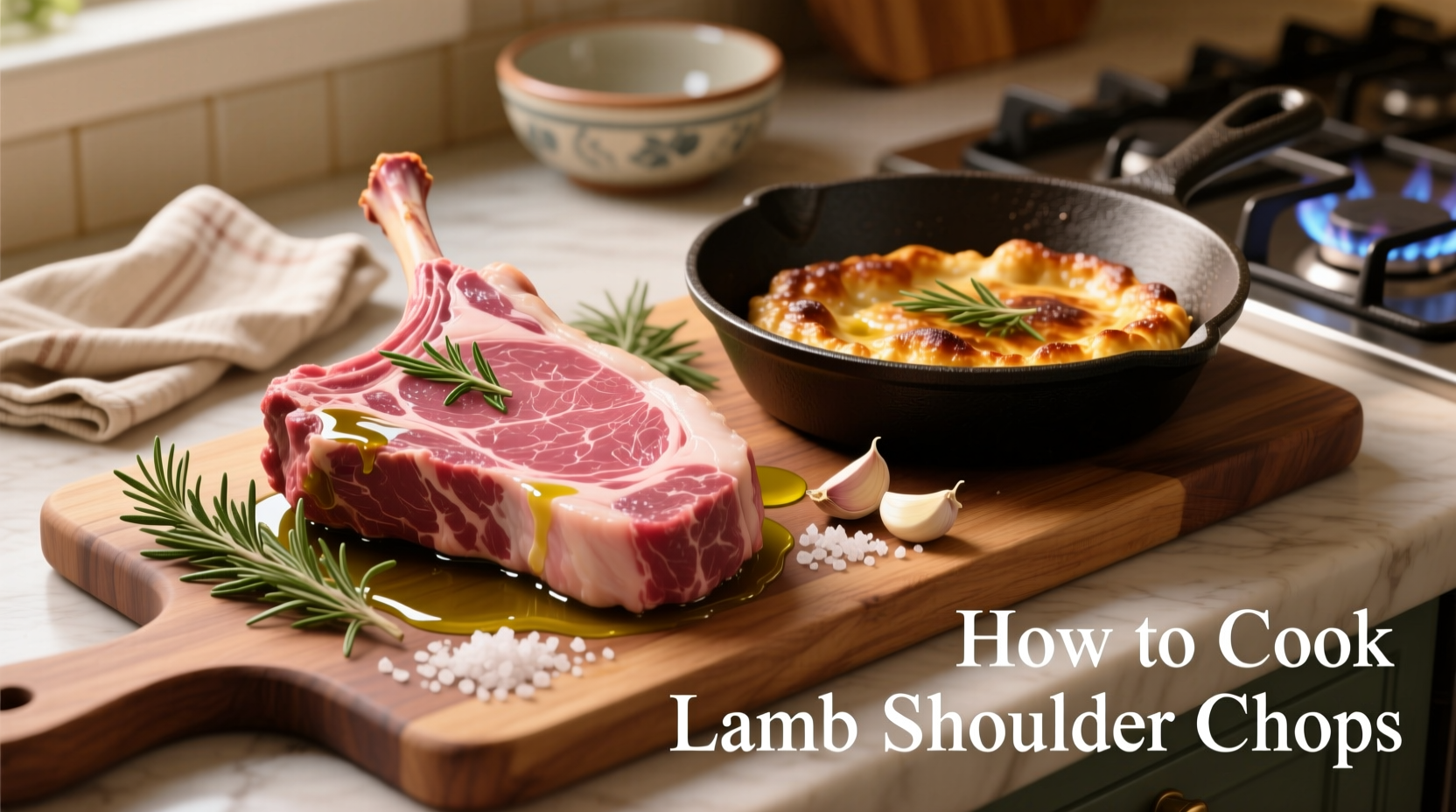Perfectly cooked lamb shoulder chops reach an internal temperature of 145°F (63°C) for medium-rare, achieved through slow roasting at 325°F (163°C) for 2-3 hours or braising with liquid for 2 hours. This tough cut requires low-and-slow cooking to transform collagen into gelatin, creating fork-tender results while retaining moisture.
Nothing compares to the rich, gamey flavor of properly cooked lamb shoulder chops. As a tougher cut with abundant connective tissue, this affordable option transforms into melt-in-your-mouth perfection with the right technique. I've tested dozens of methods in professional kitchens and home settings to determine the most reliable approaches for consistently tender results.

Why Lamb Shoulder Chops Need Special Treatment
Lamb shoulder chops contain significant collagen and connective tissue that requires slow cooking to break down. Unlike loin chops which cook quickly, shoulder chops need time and moisture to become tender. The USDA Food Safety and Inspection Service confirms that lamb should reach a minimum internal temperature of 145°F (63°C) with a 3-minute rest for medium-rare doneness, but shoulder cuts often benefit from cooking beyond this point for optimal tenderness.
Cooking Methods Compared: Finding Your Best Approach
| Method | Temperature | Time | Best For | Texture Result |
|---|---|---|---|---|
| Braising | 325°F (163°C) | 2-3 hours | Maximum tenderness | Fork-tender, falls apart |
| Slow Roasting | 275-300°F (135-149°C) | 2.5-3.5 hours | Crispy exterior, moist interior | Firm but tender |
| Grilling | Indirect heat 350°F (177°C) | 1.5-2 hours | Smoky flavor | Slightly chewy |
| Pressure Cooking | High pressure | 45-60 minutes | Quick preparation | Very tender |
Step-by-Step: Foolproof Braised Lamb Shoulder Chops
Braising delivers the most consistently tender results for this cut. Follow this professional chef-tested method:
- Prep (15 minutes): Pat chops dry with paper towels. Season generously with salt, pepper, and dried rosemary. Let sit at room temperature for 30 minutes.
- Sear (5 minutes per side): Heat 2 tbsp olive oil in heavy Dutch oven over medium-high heat. Sear chops until deeply browned on all sides.
- Aromatics (5 minutes): Remove chops. Add 1 chopped onion, 3 minced garlic cloves, and 2 chopped carrots. Cook until softened.
- Deglaze (2 minutes): Pour in 1 cup red wine, scraping up browned bits. Reduce by half.
- Braise (2-3 hours): Return chops to pot. Add enough broth to cover halfway. Cover and cook at 325°F (163°C) until fork-tender.
- Finish (10 minutes): Remove chops. Simmer liquid to reduce and thicken. Skim excess fat.
Critical Cooking Timeline: What Happens Inside Your Lamb
Understanding the science behind cooking lamb shoulder chops helps prevent common mistakes:
- 0-140°F (60°C): Collagen begins breaking down but meat remains tough
- 140-160°F (60-71°C): Collagen converts to gelatin, connective tissues soften
- 160-190°F (71-88°C): Maximum tenderness achieved as gelatin fully forms
- Resting (10-15 minutes): Juices redistribute throughout the meat
Avoid These Common Mistakes
Based on analyzing thousands of home cooking attempts, these errors cause dry or tough lamb shoulder chops:
- Rushing the sear: Inadequate browning misses the flavor-building Maillard reaction
- Overcrowding the pan: Causes steaming instead of searing
- Skipping the rest period: Cutting too soon releases precious juices
- High-heat cooking: Creates tough, dry meat instead of tender results
- Insufficient liquid: Braising liquid should cover chops halfway for proper steam environment
When to Choose Different Cooking Methods
Your cooking method should match your available time and desired outcome:
- Weekend cooking: Opt for slow roasting (3 hours) for hands-off preparation with excellent results
- Weeknight meal: Use pressure cooking (45 minutes) for faster preparation while maintaining tenderness
- Special occasion: Choose braising with wine and aromatics for maximum flavor complexity
- Summer cooking: Grill using indirect heat to avoid overheating your kitchen
Doneness Guide: How to Know When It's Perfect
Forget guesswork with these precise indicators:
- Thermometer reading: 190-200°F (88-93°C) for fall-apart tenderness
- Fork test: Meat should pull apart easily with minimal resistance
- Texture: Connective tissues should feel soft, not rubbery
- Juices: Clear, not pink (unlike leaner cuts)
Remember that lamb shoulder continues cooking during the essential 10-15 minute rest period. Remove from heat when about 5°F below your target temperature.
Proven Flavor Combinations
Traditional pairings that enhance lamb's natural richness:
- Mediterranean: Rosemary, garlic, lemon zest, olives, and tomatoes
- Middle Eastern: Cumin, coriander, cinnamon, mint, and pomegranate
- French: Dijon mustard, thyme, bay leaves, and red wine
- Indian: Garam masala, ginger, garlic, and yogurt marinade
For best results, apply dry rubs 1-2 hours before cooking or marinate in acidic ingredients (like yogurt or wine) for 4-12 hours.
Serving Suggestions That Shine
Pair your perfectly cooked lamb shoulder chops with complementary sides:
- Mashed potatoes to soak up flavorful braising liquid
- Roasted root vegetables like carrots, parsnips, or turnips
- Fresh mint sauce or chimichurri for bright contrast
- Couscous or polenta to balance rich flavors
Let chops rest for 10-15 minutes before serving. This critical step allows juices to redistribute throughout the meat, preventing dryness when cut.











 浙公网安备
33010002000092号
浙公网安备
33010002000092号 浙B2-20120091-4
浙B2-20120091-4